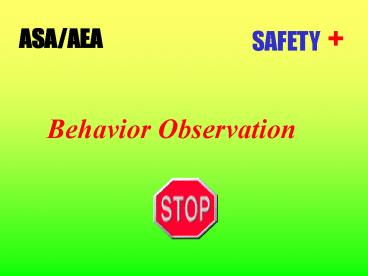Behavior Observation - PowerPoint PPT Presentation
1 / 15
Title:
Behavior Observation
Description:
SAFETY + ASA/AEA Behavior Observation Unsafe Acts Are Responsible For 98% Of All Incidents If Unsafe Acts Are Not Recognized and Controlled They Will Continue Until ... – PowerPoint PPT presentation
Number of Views:229
Avg rating:3.0/5.0
Title: Behavior Observation
1
SAFETY
ASA/AEA
Behavior Observation
2
Unsafe Acts Are Responsible For 98
Of All
Incidents
3
If Unsafe Acts Are Not Recognized and
Controlled They Will Continue Until An Incident
Results. The Process of Elimination Must Start
With You!
4
This is the result of an unsafe act. Several
members of this employees crew stood by and
watched as he tried to maneuver a suspended load
into a pipe basket without a tagline. After the
incident all of them said, I wished I had
stopped the activity and talked about a better
way to do the job.
5
It Is My Companys Understanding That You Are In
The Best Position To Recognize Unsafe Acts on
Your Location. It Is My Expectation That You
Will Stop Unsafe Acts Before An Incident Occurs.
6
There are several different behavior
observation programs. It is not as important
which one you and your company choose to utilize,
it is important that you use the process
correctly. Too often behavior observation cards
are filled out without proper discussion just to
meet a quota, or without enough information to be
used for future benefit. Take the time to train
employees and monitor the program, or no one will
benefit.
7
Step 1 Observe work as it is taking place. Quite
often you will be involved in the work yourself.
- Observe peoples activity, their actions
- and surrounding environment.
- Be careful not to startle or interrupt
- a worker at an inappropriate time.
- Look for unsafe acts as well as good
- safety performance.
- Look for detail and an overall impression.
- Keep an open mind.
8
Step 2 If you see an act or condition that is
unsafe or you think may be unsafe, stop the job
and discuss the situation with the individual(s)
involved.
- Stop unsafe acts immediately, unless
- stopping the worker will create a greater
- hazard. If the action is not immediately
dangerous to life and health, use your judgement
to decide if it is better to wait for a few
moments. - Be considerate and understanding, treat
- a worker the way you would expected to be
treated.
9
Step 3 Ask the person or persons involved in the
job to explain what they are trying to
accomplish and what the procedures are.
- Ask
- Can you tell me about the job?
- What are the hazards and risks?
- Have you completed a JSA/RAT?
- Do you have a written procedure?
- Why do you think I stopped you?
10
Step 4 Ask them, what are some things that could
go wrong and how are some ways they could get
hurt during the job.
- Ask
- What could go wrong with the job?
- How could you or others be hurt?
- Who else would be affected if you were
- injured?
11
Step 5 Ask, what are some ways they could
complete the job safer. (change in procedures,
different tools, PPE)
- Allow the worker to explain how he
- believes the job can be done more
- safely.
- Your job is to listen, a worker that
- is allowed to find his own solution
- to a situation is more likely to do the
- job right in the future.
- If necessary, act as a coach to help
- change unsafe behavior.
- Provide praise when a job is being
- done correctly.
12
Step 6 Make an agreement to correct the
situation and complete the job safely. Everyone
involved will benefit!
13
Step 7 Complete the appropriate behavior
observation card. Be sure to mark all the
required boxes and provide a brief summary of the
unsafe act and corrective action.
- Be specific and check the appropriate
- category and box(s) that apply
- Give brief description of observation
- in comment section
- List any corrective actions and dates
- they are to be completed
- Provide name of person(s) completing
- the observation
- Submit card for review and processing.
- Data can be tracked and trended dy management
to improve.
14
Finally, share your behavior observation card
with the entire crew so that everyone can benefit
and work safer. The results are obvious
Or This
This
15
Dont let this happen to you or one of your
buddies!































